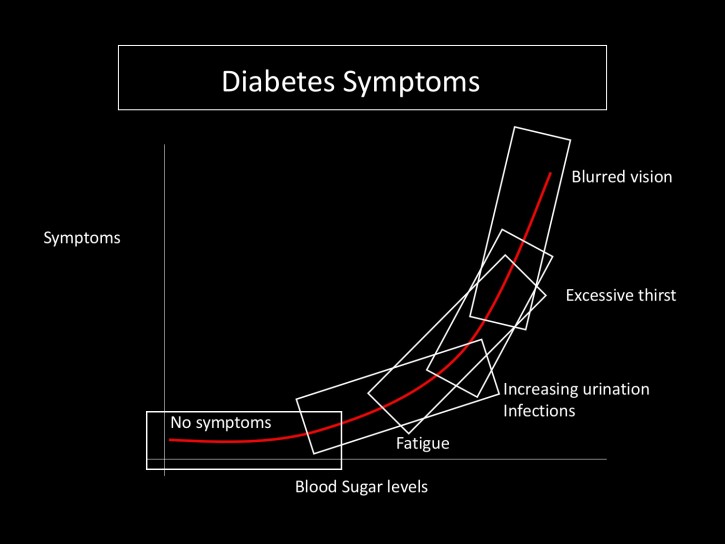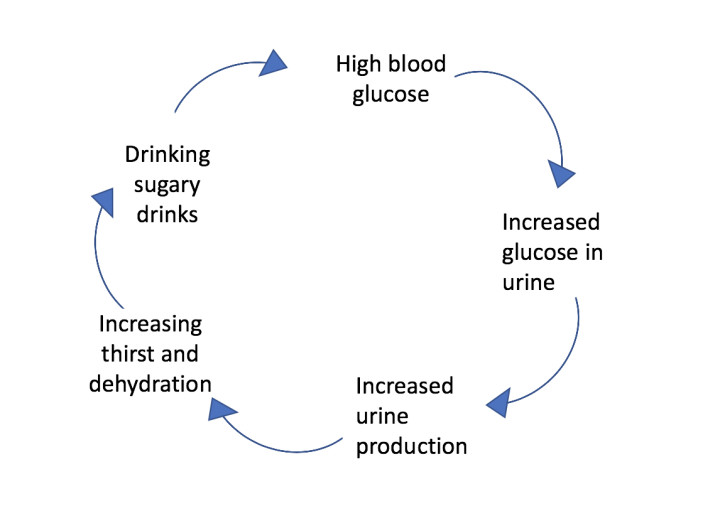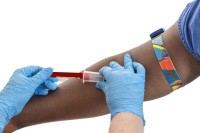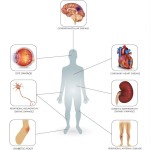- Home
- Dr Sultan Linjawi
Type 1 Diabetes
Type 2 Diabetes
Prediabetes
Gestational Diabetes
- Diabetes Information
- Testimonials
What are type 2 diabetes mellitus symptoms?

DO YOU WANT TO GET YOUR DIABETES UNDER THE BEST CONTROL?
Click the program that best describes your situation.
What is Type 2 Diabetes?
Type 2 diabetes is rapidly becoming of the most common long-term disease in the world. The problem causing an elevation in the blood glucose levels occurs when there is a change in the shape of the insulin receptor. In the normal situation, the body produces a small chemical called insulin (key) whose purpose is to bind to a receptor (lock) on the surface of fat and muscle cells, opening a channel to allow glucose to enter those cells. In type 2 diabetes the shape of this receptor changes mostly as a consequence of weight gain around the stomach.
Type 2 Diabetes Content |
|---|
| Type 2 Program |
| Overview |
| Risk Factors |
| Symptoms |
| Diagnosis |
| Complications |
| Treatment |
| Diet |
| Monitoring |
| Tools |
| Mental Health |
| Prevention |
What are the symptoms of type 2 diabetes mellitus?
Have you ever wondered what the symptoms of type 2 diabetes are? There are similarities across type 1 and type 2 diabetes, but there are also a few key differences too. People with all types of diabetes can, but not necessarily, have a shorter life expectancy. The presence of diabetes does not in itself lead to a shorter life, but rather having high blood sugar levels does. Having good control of sugar levels will cause a person with diabetes to live as full and healthy a life as anybody else. For this reason, it is important to understand and recognise any symptoms relating to diabetes. Diagnosing diabetes mellitus early can save your life in the short term but with proper management of the condition long term complications can be avoided too.
Diabetes is a common condition affecting more and more people every day. In 2016, diabetes was the direct cause of death in 1.6 million people (WHO, 2018) worldwide. If we consider death from diabetes related conditions, it is estimated to lead to the death 4 million people every year around the world, more than malaria, TB, and HIV combined.
In type 2 diabetes mellitus, symptoms that you experience are related to:
a) the severity of diabetes, i.e. how high your blood glucose levels are,
and
b) how long you have had the condition, i.e. how long you have had high blood glucose levels for.
When a person initially develops type 1 diabetes, the beta cells of the pancreas rapidly fail to produce adequate amounts of insulin. Since there is little insulin, blood glucose levels rise very quickly. The symptoms of diabetes happen rapidly, are severe, and people notice that they are unwell quite quickly. If a person develops type 1 diabetes slowly, then these symptoms may take months to develop but often it is weeks.
In people with type 2 diabetes, the progression of the condition happens much more slowly, over the course of several years, so the symptoms happen slowly and are often subtle. You may not even notice anything at all, or you may even dismiss them as a normal part of growing older.
By the time that you notice something isn’t quite right, you could have been experiencing high blood glucose levels for years! Often people who are diagnosed with type 2 diabetes, have had diabetes for perhaps 5 years and borderline diabetes for many years before that.

What is the most common symptom in people with type 2 diabetes?
The most common sign of diabetes is…
Nothing.
That’s right. Nothing. The reason that doctors need to test for diabetes (and people need to demand it), is that most people have no idea that they have it. This regular testing is most important in people at the highest risk of developing diabetes.
If you want to learn how type 2 diabetes mellitus can affect men and women differently, we have also written dedicated articles to answer your questions:
What are the symptoms of type 2 diabetes?
- Nothing
- Fatigue and irritability
- Excessive thirst, frequent urination, and dehydration
- Hunger
- Yeast and bacterial infections
- Dry and itchy skin
- Cuts and wounds that don’t heal quickly
- Blurred vision
- Weight loss
Fatigue and irritability
Fatigue is another common type 2 diabetes symptom. You may often feel tired, regardless of how much you have eaten, because your cells are not able to use the glucose that is broken down from the food.
If you’re needing to make a lot of trips to the bathroom at night, this can also disrupt your sleep. Waking up multiple times throughout the night could mean you aren’t able to get a restful sleep, leaving you to feel tired throughout the day. This ongoing fatigue can make you easily irritable. It’s no wonder why you may be feeling more grumpy than usual!
Excessive thirst, frequent urination, and dehydration
When your blood glucose levels are high, a lot of the glucose passes into the urine. Because you lose so much glucose in your urine, it also attracts water, meaning that you are making a lot of urine, causing you to need to pee a lot! If you are going to the toilet a lot and losing a lot of urine, then you are quickly becoming dehydrated. If you are dehydrated, you become thirsty. People who feel they need to constantly drink lots of water may have diabetes and it needs to be tested for.
If a person with high sugar tries to deal with their thirst by drinking sugar containing fruit juice or soft drinks, then the blood sugar can become even higher, resulting in even more sugar in the urine, even more urine production, and worsening dehydration. It’s a vicious cycle.

Ongoing hunger
We get energy, like glucose, from the foods that we eat. People with type 2 diabetes, have little glucose entering the muscle cells, so the body will signal that it needs more food even though there is plenty in the blood. You may have ongoing hunger, regardless of how much you have already eaten, because the body is craving more energy.
Yeast and bacterial infections
Yeast and other fungi use glucose for energy and thrive in an environment that is high in sugar. Yeast infections can occur in both men and women. Infections can grow in any place on the body that is a warm, moist fold of the skin, including:
- Between fingers and toes
- Under breasts
- In or around sex organs
People with high blood sugars due to type 2 diabetes also have a high risk of developing bacterial infections like urinary infections, chest infections, and skin infections and boils. The cells that fight infections are called neutrophils and their function is impaired if the glucose level is above 11mmol/l (or 200mg/dl).
Dry and itchy skin
When the body is dehydrated, our skin can become dry and feel itchy. Dry and itchy skin is more easily able to break, causing a cut or wound.
Cuts and wounds that don’t heal quickly
Neutrophils, white blood cells that fight any infection in our body, are sensitive to high blood glucose levels. These are a very important part of the immune system and are at the front line of a person's defences, keeping bacterial infections at bay. In a person with type 2 diabetes, the ability of neutrophils to fight infections decreases, causing you to be less likely to able to fight infections, like a cut or a wound found on your foot.
Pain and numbness in your feet or legs
Pain and numbness in the feet are another sign of high glucose levels and can indicate nerve damage. Damage to nerves is called neuropathy and when it affects the feet and lower legs is called peripheral neuropathy. You might be experiencing pins and needles in your feet, a woolly sensation in the feet or pain. In a person with diabetes, if there is numbness in their feet, they may not even realise if they have a cut or a wound. This can lead to unrecognised damage that can spread and is the leading cause of amputation in people with type 2 diabetes.
Blurred vision
This is a common complaint. Blurry vision occurs when glucose enters the lens in the eye ball. This causes it to swell, changing its shape and changing the refraction. This leads to a change in your eyesight. Some people will develop blurred and others might even notice an improvement in the eye sight! When the glucose levels fall back to more normal levels the lens changes shape again leading to a change in the visual acuity and a person’s eyesight. Many people are picked up as having type 2 diabetes by the opticians when they go for an eye check but is important to not get new glasses until the glucose levels are stable.
Weight loss
If you have type 2 diabetes, there may come a time where you losing weight and experience weight loss despite eating normally. This occurs when the glucose levels are very high and the pancreas is failing. This is a sign of severe diabetes. This results in not enough glucose being absorbed in the cells to be used for energy, so your body starts to breakdown fat and muscle instead, leading to the weight loss.
These symptoms are all related to diabetes and high blood sugars but ultimately the concern with diabetes is that things can go wrong with the body. When things go wrong and complications of type 2 develop other symptoms can be present that relate to the specific complication.
Complications of type 2 diabetes are either due to large blood vessels which are called macrovascular complications or small blood vessels called microvasculuar complications. Macrovascular complications can be life threatening and take seriously. Type 2 diabetes complications
Macrovascular complications - Problems with large blood vessels include:
- Coronary artery disease which can lead to a heart attack called cardiovascular disease.
- Cerebrovascular disease which can lead to a stroke or cerebrovascular disease.
- Peripheral artery disease which can lead to pain deep in the leg muscles (calves, thigh, or buttocks) during activity as well as amputations. This is referred to as peripheral vascular disease.
Microvascular complications - Problems with small blood vessels include:
- Retinopathy – Disease of the eye which can lead to blindness.
- Neuropathy – Disease of the nerves which can lead to foot ulcers requiring amputation.
- Retinopathy – Disease of the eye which can lead to blindness.
- Nephropathy – Disease of the kidneys which can lead to kidney failure and the need for dialysis.
Are there other conditions associated with type 2 diabetes mellitus?
Type 2 diabetes is part of a group of disorders grouped together and known as the metabolic syndrome. Metabolic syndrome also includes high blood pressure, or hypertension, as well as disorders of cholesterol levels. Often people may have these conditions prior to being diagnosed with type 2 diabetes.
What are the risk factors for developing type 2 diabetes mellitus?
There are a number of type 2 diabetes risk factors which increase your chance of developing type 2 diabetes. These include:
- Have a family history of diabetes
- Being overweight or obese, particularly extra weight around the waist
- Being physically inactive
- Eating a poor diet (one that is high in fat, salt, and sugar)
- High blood pressure
- Having signs associated with diabetes like skin tags and dark colouration around the neck and arm pits called acanthosis nigricans
- Being older (over 55 years of age) – the risk increases as we age
- Over 45 years of age and being overweight
- Over 45 years of age and being overweight
- Ethnic background, including Aboriginal and Torres Strait Islanders, Pacific Islanders, Asian and South East Asian, African Americans, Native Hawaiians, and Hispanics/ Latinos
What should I do next?
If you experience any symptoms of type 2 diabetes or you have type 2 diabetes risk factors, it is important to get tested for as soon as possible. Some people are at higher risk and need regular testing. If you are 45 years or older or have other risk factors for diabetes, you will require more frequent testing. By diagnosing and treating the type 2 diabetes early, it means you can decrease the risk of developing diabetes or delay type 2 diabetes complications, for example nerve damage, blindness, and heart disease. It is important to know that diagnosing type 2 diabetes should not rely solely on using a Hb A1c test.
Once you learn what your type 2 diabetes status is, or if you already have type 2 diabetes, the next most important step is to become educated. You can join the 12-week Type 2 Diabetes Program to help you learn how to prevent or delay type 2 diabetes. The program is personalised and tailored, giving you more of the content that you want. The program also helps you to stay motivated and teaches you what changes you need to make. The first week is free and full of helpful and crucial information.
If you would like to be a part of a supportive program, with easy to understand video content covering all aspects of diabetes, join our personalised 12-week Type 2 Diabetes Program today! Don't forget, when you sign up, you receive the first week free!
Interested in more information on type 2 diabetes?
Follow the links below to learn more about type 2 diabetes.









